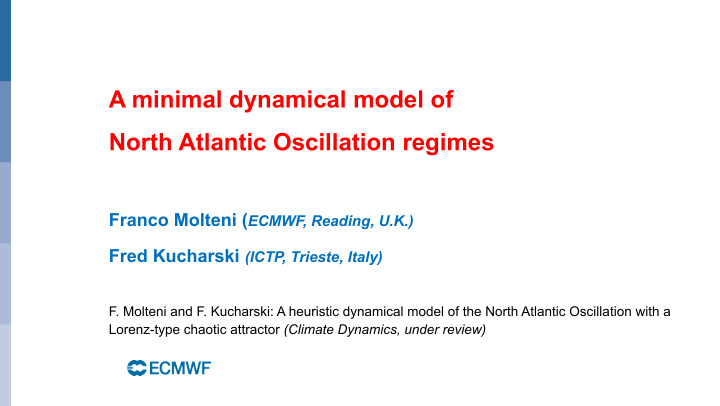



A minimal dynamical model of North Atlantic Oscillation regimes Franco Molteni ( ECMWF, Reading, U.K.) Fred Kucharski (ICTP, Trieste, Italy) F. Molteni and F. Kucharski: A heuristic dynamical model of the North Atlantic Oscillation with a Lorenz-type chaotic attractor (Climate Dynamics, under review)
Covariances of geop. height with NAO index (from ERA-interim) ICTP School on Multiple Equilibria – June 2018 2
Statitionary waves at 850 hPa: meridional wind (v) and temperature (T) If the stationary waves had a geostrophic, equivalent barotropic structure, the v and T eddies would be orthogonal. In reality, v* and T* are positively correlated, so that heat is transported northward in mid-latitudes: [v*T*] > 0 ICTP School on Multiple Equilibria – June 2018 3
Interactions of an equiv. barotropic anomaly with baroclinic stationary waves ICTP School on Multiple Equilibria – June 2018 4
Meridional heat transport by the NAO anomaly ICTP School on Multiple Equilibria – June 2018 5
Covariances of surface heat fluxes with NAO anomaly HF = c H ρ│ V 0 │ (H s – H a (z=0) ) H = c p T + L c q Over the North Atlantic, anomalies in │ V 0 │ give a large contribution to HF variability. Assuming a uniform heating between the sfc and ~ 300hPa, a regression of the heating tendency as a linear function of the temperature tendency gives a damping time of ~ 10 days ICTP School on Multiple Equilibria – June 2018 6
3-variable NAO model: definition of basic functions and DOF North America / Atlantic / Europe (NAE) channel: 135W-45E, 35N-65N U A ~ NAO index B ICTP School on Multiple Equilibria – June 2018 7
3-variable NAO model: vorticity advection ICTP School on Multiple Equilibria – June 2018 8
3-variable NAO model: meridional and vertical heat fluxes • Divergence of meridional heat transport • Thermal dissipation due to surface heat fluxes • Relaxation towards forced state driven by long-wave radiative damping From NAO statistics: γ ≈ 2, σ ≈ 2, κ ≈ 0.5 ICTP School on Multiple Equilibria – June 2018 9
3-variable NAO model: equivalence to the Lorenz 1963 model Setting: B’ = B – B*, U* = 0, γ ≈ σ ICTP School on Multiple Equilibria – June 2018 10
Chaotic attractor of the 3-variable NAO model A , B ICTP School on Multiple Equilibria – June 2018 11
Atmospheric energy cycle (after Lorenz) From Wikipedia ICTP School on Multiple Equilibria – June 2018 12
A non-linear oscillator model for high-frequency eddies • Ambaum and Novak ( QJRMS 2014) • Novak et al. ( JAS 2015) ICTP School on Multiple Equilibria – June 2018 13
Atmospheric energy cycle (after Lorenz) U’ (z) = U’ th ( ∂ T/ ∂ y) + U’ btr E hf U’ (z =0 ) = U’ btr ICTP School on Multiple Equilibria – June 2018 14
A 5-variable model with zonal flow/baroclinic eddies interactions We can write the zonal wind at the equivalent barotropic level as the sum of a height- independent barotropic component and a thermal component: High-frequency baroclinic eddies grow at the expense of zonal available potential energy and decay by surface drag and conversion of kinetic energy into the zonal-mean barotropic flow ICTP School on Multiple Equilibria – June 2018 15
Attractor of the 5-variable NAO model U’ th , U’ btr, E hf A , B ICTP School on Multiple Equilibria – June 2018 16
Lead-lag relationship between zonal wind and h.f. eddy amplitude ICTP School on Multiple Equilibria – June 2018 17
Summary • Regimes in the NAO can exist because of the balance of a positive and a negative feedback between the zonal and eddy component components of the NAO anomaly in the North America/Atlantic/European (NAE) sector, and the associated surface heat fluxes. • The positive feedback is associated with the strengthening of the zonal-mean temperature gradient due to the interaction of the NAO anomaly with climatological stationary waves of wider meridional scale. In turn, vorticity advection by the increased zonal-mean wind forces a positive NAO anomaly. • The negative feedback is due to thermal damping caused by the heating anomalies driven by surface fluxes. Over the North Atlantic, these fluxes are strongly controlled by the near- surface zonal wind speed. • A simple 3-variable model including the effects of vorticity advection and the two feedbacks described above is formally equivalent to the Lorenz (1963) convection model, and has a chaotic attractor with two regimes. • The model can be extended by incorporating non-linear oscillators that describe the energy conversions associated with the growth and decay of baroclinic eddies. The resulting 5-var model still shows a chaotic attractor with increased variability at sub-seasonal scale. ICTP School on Multiple Equilibria – June 2018 18
Recommend
More recommend